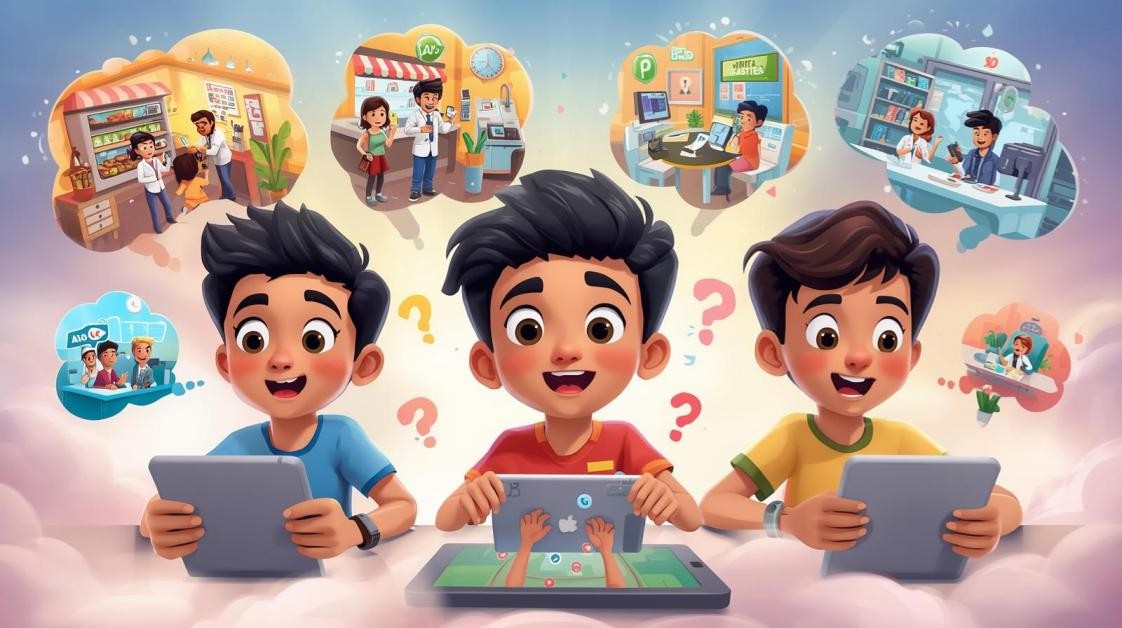
Digital Applications Supporting Role-Playing in Language Learning
Introduction
Role-play as a language-learning strategy is gaining increasing prominence in digital education because it enables learners to practice a foreign language in authentic yet low-risk situations. Through this approach, students simulate real-life interactions, such as ordering food in a restaurant, speaking at a service counter, or negotiating, thereby not only mastering linguistic structures but also cultivating creativity, spontaneity, and confidence in communication. Digital tools that support role-play, including mobile applications, web-based platforms, and VR/AR PROGRAMS with carefully designed scenarios and simulations, are particularly valuable. They allow children to engage in enjoyable, authentic tasks by assuming different roles (tourists, shopkeepers, students, doctors, travelers), thus encouraging natural use of the target language in context, free from pressure or fear of making mistakes.
Why Is Role-Play Beneficial?
Role-play in language learning offers a range of advantages that go far beyond simple memorization of vocabulary. Above all, it promotes active learning and the use of language in realistic contexts, enabling children to develop communication skills more naturally. Practising in a safe and supportive environment boosts their speaking confidence and reduces anxiety about making mistakes. Another strength of this approach lies in its adaptability: scenarios and activities can be tailored to each learner’s age and proficiency level, allowing every child to progress at an individual pace. Moreover, role-play often incorporates the cultural dimension of communication, fostering intercultural competence, an essential skill in today’s interconnected world.
Features of These Applications
Modern digital applications designed for role-play in language learning are created to make the learning experience engaging and as close to real-life situations as possible. They offer carefully developed scenarios drawn from everyday contexts, from buying a ticket or ordering food, to attending a job interview or meeting new people. A key strength of these tools is their interactivity: children can converse with virtual characters or communicate with peers via the app, while many programs integrate speech-recognition technology and provide feedback on pronunciation, helping learners refine their articulation. Gamified elements, such as points, rewards, and levels, further enhance motivation, while flexible settings support independent practice with AI assistance, as well as pair or group activities online. Multimedia resources, text, audio, images, and even VR/AR technologies, enrich the learning process, immersing children in authentic language-use scenarios.
Examples of Digital Applications and Tools
- Duolingo Roleplay – Simulated conversations in real-life situations. The Roleplay feature is available only with the Duolingo Max subscription (not included in the free plan). Availability is limited to selected languages and not rolled out across all courses yet.
- Mondly VR – Language learning in virtual reality through dialogues with avatars. Freemium model: limited free content is available in the app, but the full VR experience requires a paid subscription.
- Immerse – A dedicated VR application for interactive lessons and role-playing. A 7-day free trial is offered, but full access to all lessons and features requires a paid subscription.
- FluentWorlds, LinguaLife – Apps featuring 3D environments and role-play communication. Freemium model: basic access is free, but extended environments and advanced features are unlocked via subscription.
- Classcraft – A general gamified education platform that can be adapted for language learning through role-play. Freemium model: core features are free, while premium classroom management and advanced customization options require payment.
This is an area where platform development is expected to advance even further, as role-play has proven to be an effective method for learning foreign languages, applicable across all ages and proficiency levels.

AI-Supported Applications
Modern language-learning applications are increasingly leveraging artificial intelligence to enrich role-play experiences and support the development of communicative skills. Key benefits include:
- AI-GFCA Model – The integration of AI into the Generalization, Formulation, Correction, and Assessment (GFCA) model significantly enhances learners’ fluency, pronunciation, and overall performance in real-life scenario simulations.
- Real-Time Scenario Simulation – Tools such as ChatGPT allow learners to engage with virtual conversational partners, practicing language through dynamic and realistic dialogues.
- Enhanced Motivation and Engagement – AI-driven interaction makes the learning process more engaging by offering immediate feedback and creating a safe space for experimentation without fear of mistakes.
- Practical Use of Popular Tools – Research (Oshmjanski, Krželj & Mirić, 2024) shows that students most frequently use ChatGPT, Google Translate, and Duolingo, underlining the importance of careful planning and pedagogically sound integration of these tools into teaching practice.
Learning in Virtual Reality (VR)
- Virtual agents in VR environments create contextualized role-play simulations, provide feedback, and adapt to learners’ individual needs.
- Multimodal approaches, including text, images, audio, and digital tools, further enrich the learning experience and reduce barriers between language and context (Vidosavljević, 2021).
Digital Tools for Gamification
- Digital Games – MMORPGs require communication in a foreign language and expand vocabulary through interaction with other players.
- Storytelling and AR Tools – Students engage in narrative scenarios and learn actively through stories, forming a foundation for role-play activities.
- Mobile Applications – These provide additional opportunities for language learning on the go, increasing student motivation and engagement (Bogdanović, 2024).
Advantages of Using Digital Tools in Language Learning
The use of modern digital tools offers numerous benefits in the process of mastering a foreign language. Primarily, they foster autonomy and motivation, allowing learners to study independently while receiving continuous feedback that guides their progress. These tools support the development of linguistic skills by improving pronunciation, speech fluency, and reducing communication errors. Virtual environments also provide a sense of safety, enabling children to overcome anxiety and express themselves more freely. Gamification and the use of VR technology make lessons more engaging and dynamic, enriching the overall learning experience. Research conducted in Serbia (Maenza, Gajić, Veljković Michos & Gagić, 2024) indicates that secondary school language teachers recognize the value of digital tools but emphasize the importance of institutional support to maximize their effective use in teaching.
Findings from various studies show that asynchronous online role-play significantly increases students’ willingness to communicate in English. It has been particularly observed that students develop greater confidence and collaboration skills after such activities, with their success influenced by both linguistic and non-linguistic factors, as well as technical skills. The learning process was structured through multi-week cycles encompassing preparation, execution, and reflection, highlighting the importance of continuous practice and evaluation. Although technical challenges such as device quality and internet connectivity were noted, the research confirms that asynchronous role-play represents a promising and sustainable method for foreign language learning, especially in the post-pandemic context. This approach provides students with a flexible and safe environment in which they can practice communication, develop language skills, and build long-term confidence in expression.

Conclusion
Digital applications that support role-play represent a modern, dynamic, and motivating approach to foreign language learning. Their strength lies in the combination of interactive scenarios, artificial intelligence, VR/AR technologies, and gamified elements, enabling learners not only to study the language but to actively experience it through real and engaging situations. This approach fosters curiosity, creativity, and communication confidence, while simultaneously developing key competencies, from accurate pronunciation and speech fluency to intercultural sensitivity and critical thinking. Research conducted in Serbia confirms that the use of digital tools, when supported by a clear pedagogical strategy and institutional backing, can significantly enrich language instruction. By investing in the development and thoughtful application of these technologies, parents and teachers can collaboratively help children acquire a foreign language in a natural, enjoyable, and sustainable way.
References
- Faculty of Teacher Education, University of Belgrade. (2025). Digital Institute – Empowering Teachers for Digital Education.
- Kuzmanović, D. (2025). Learning in a Digital Environment. Master’s Program “Language, Literature, Culture”.
- Faculty of Teacher Education, University of Belgrade. (2025). Teacher for a Digital Society – Enhancing Digital Competences.
- Vidosavljević, M. M. (2021). The Role of the Teacher in the Implementation and Development of Multimodal Learning in Foreign Language Teaching (Doctoral dissertation, University of Belgrade).
- Oshmjanski, V., Krželj, K., & Mirić, M. (2024). The Use of Digital Tools and Artificial Intelligence in Professional Foreign Language Learning. Philological Horizons, 3, 185–208.
- Nikolić, I. A., Banđur, V. R., & Martinović, D. D. (2020). The Role of the Teacher in the Digital Age School. Sociological Review, 54(1).
- Maenza, N., Gajić, T., Veljković Michos, M., & Gagić, A. (2024). Understanding the Role of Digital Tools in Foreign Language Teaching in Serbian Secondary Schools.
- Gagić, A., Gajić, T., Gavranović, V., Maenza, N., & Veljković Michos, M. (2023). Digital Tools for Language Learning: Research on Innovative and Engaging Teaching Practices.
- Bogdanović, M. (2024). Mobile Learning in Primary School Teaching. Pedagogical Reality, 1.
- (2023). The use of asynchronous online role-play to improve ESL learners’ willingness to communicate. FBK, Universiti Pendidikan Sultan Idris. https://files.eric.ed.gov/fulltext/EJ1395852.pdf?utm_source=chatgpt.com
